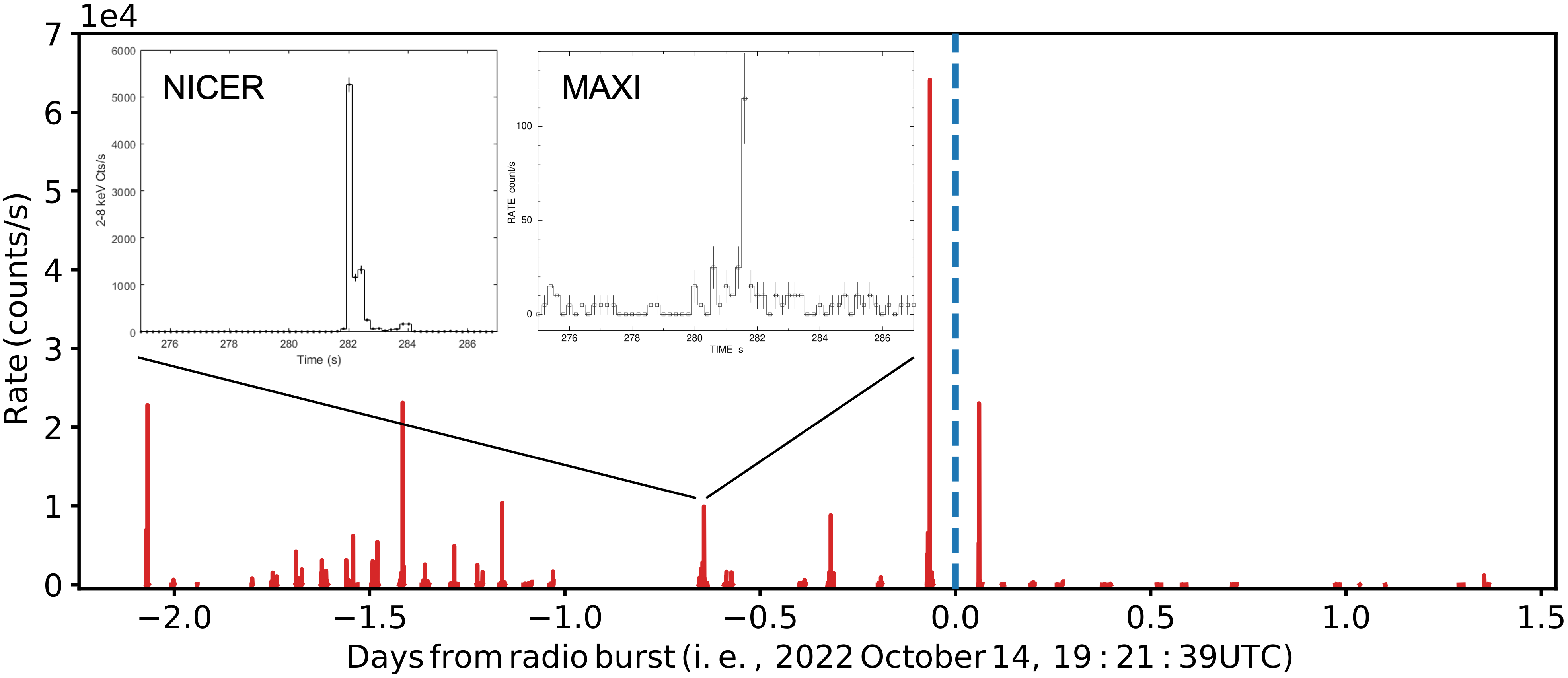NICER / ISS Science Nugget
for October 20, 2022
Observing an Outburst from the Fast Radio Burst source SGR 1935+2154 with NICER
Magnetars are the most extreme manifestation of neutron stars, the dense (radius ≅ 10 km, mass ≅ 1.4 solar masses) remnants of massive stars. They possess the highest magnetic field strengths known in the cosmos, surpassing 1014 Gauss, or a trillion times the strength of a refrigerator magnet. Magnetars are thus unique physics laboratories for studying matter under extreme conditions not replicable in Earth settings. A signature property of magnetars is their emission of short (0.1 seconds), bright, hard X-ray flashes. These can come in isolation, where a few are detected from a source in a matter of days, or in bunches when hundreds are emitted in the span of minutes. The latter are known as magnetar burst storms or forests; six magnetars have exhibited such storms in the last 40 years.
Fast Radio Bursts (FRBs) are millisecond-duration radio flashes of unknown origin. They have been primarily observed from extragalactic distances, that is, until one magnetar in our Galaxy, SGR 1935+2154, emitted one such FRB during its 2020 burst storm, simultaneous with an X-ray flash. This monumental discovery provided the smoking-gun evidence that magnetars are responsible for at least some FRBs, and finally allowed us to concretely study the FRB triggering and emission mechanism physics.
On 2022 October 12, SGR 1935 entered another burst-active period. NICER was able to observe the source within 3 hours of the first notification of activity by several all-sky X-ray monitors, and closely followed this burst episode over the course of a week. NICER discovered over several hundred bursts during the first two days (see Figure), and watched the intense bursting activity wind down. To add to the interest of this bursting episode, SGR 1935, in the midst of its burst storm, emitted yet another FRB-like bright radio burst that was reported independently by two radio telescopes. While NICER was not observing SGR 1935 at the time of the radio burst, it gathered the most detailed look at a magnetar mere hours before and after the FRB emission event, finding a marked diminishment in the rate of X-ray bursts after the radio burst. These observations provide invaluable data that will help us decipher the evolving state of the magnetar Ñ its magnetosphere, surface heat map, and energy output Ñ deepening our understanding of FRBs and these fascinating cosmic labs. Preliminary results of NICER's observations were reported in Astronomer's Telegrams #15674 and #15690
by T. Enoto (RIKEN) and G. Younes (NASA GSFC/George Washington U.).

Figure:
The rate of X-ray photon detection, in tens of thousands of counts per second, by NICER (red spikes) around the time of a Fast Radio Burst-like event (blue dashed vertical line) detected by radio telescopes on the ground. Each spike represents one or more X-ray bursts of lasting a few tenths of a second, on average. The lack of significant burst activity shortly after the FRB is evident. The inset plots "zoom in" on the brightness evolution, over a few seconds, of a burst that was simultaneously captured by both NICER and JAXA's MAXI payload.
<< Previous
Main Index
Next >>